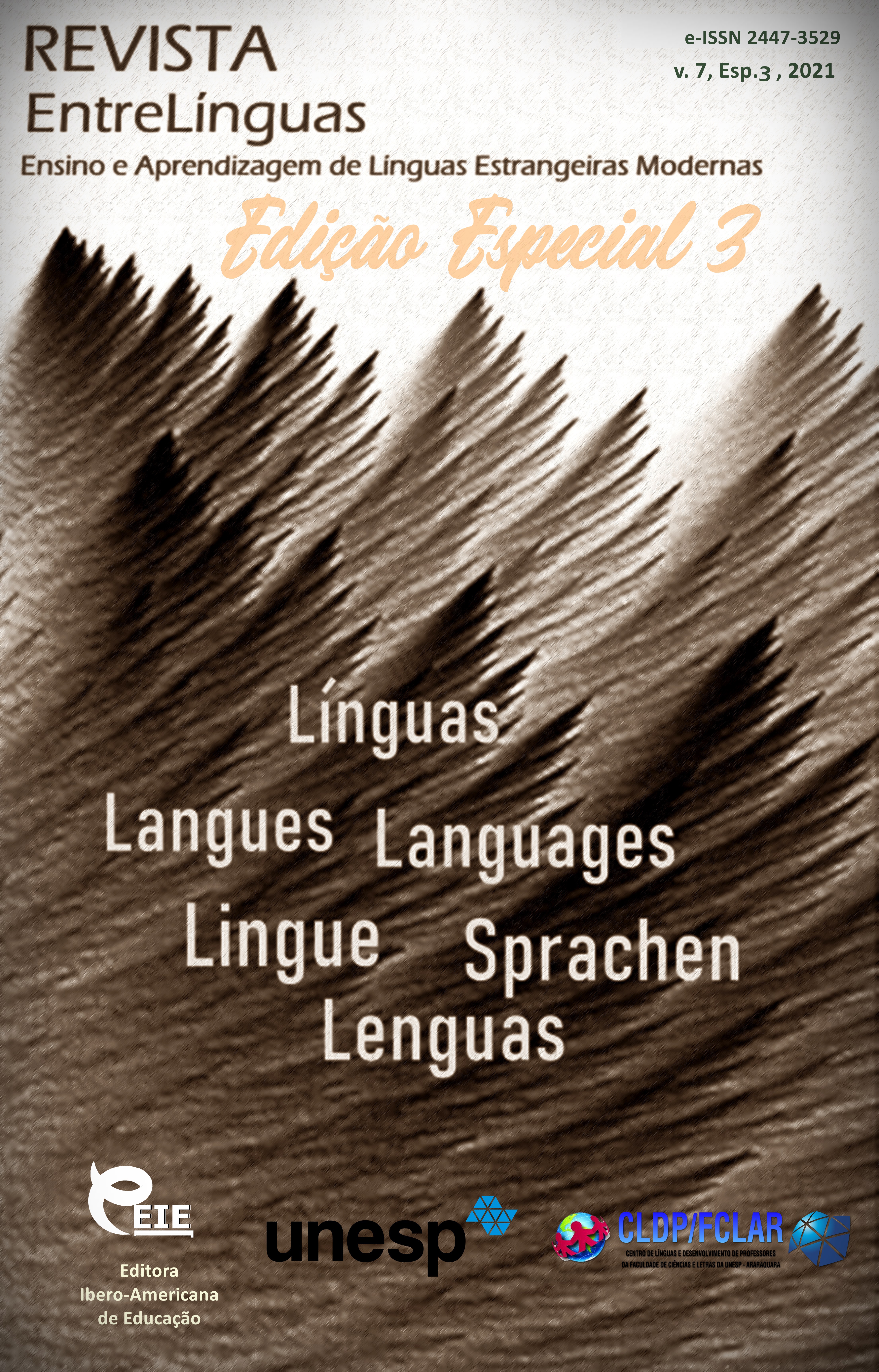Structural and semantic analysis of some physics eponym terms for contribution to teaching and communication
DOI:
https://doi.org/10.29051/el.v7iesp.3.15723Keywords:
Linguistics, Language, Structural and semantic peculiarities, Eponym termAbstract
Rapid development of new technologies and products due to discoveries in all fields of sciences, in the Physics field as well, leads to emergence of eponym terms. This phenomenon requires studying and analyzing these lexical units as they often may cause confusion for students as well as for science people in interpreting them in an appropriate way during the learning and communication processes. The relevance of the topic is in considering some linguistic peculiarities of eponyms and eponym term combinations to try to combine education issues and the results of the topic under discussion. Some structural and semantic differences of the same eponym terms in both languages may cause difficulties in their perception and intertransition. The paper provides a comparative analysis, processing, generalization and systematization of some structural and semantic peculiarities of Physics eponym terms in the English and Russian languages. On the base of the analysis of the differences of the lexical units given are the results on some linguistic peculiarities of eponyms in Physics field. The main result of the research is in revealing considerable discrepancies in the structure, meanings and ways of reflection of eponym lexical units in the analyzed languages and in the necessity of their consideration for making some possible contribution to education issues and terminology science. The practical significance of the paper is in combining linguistic analysis and language teaching technology.
Downloads
References
ABROSIMOVA, G. et al. Blended learning in university education. Humanities & Social Sciences Reviews, v. 7, n. 6, p. 06-10, 2019.
BARANOVA, A. R.; MAKAYEV, K. F.; SIGACHEVA, N. A. Diachronic tree of computer terms. Journal of Advanced Research in Dynamical and Control Systems, v. 11, n. esp. 8, p. 456-461, 2019.
GRINEV-GRINEVICH, S. V. Terminology. Moscow: Academy, 2008. 304 p.
KAKZANOVA, E. M. Nomenclature and eponymous terms: a review of opinions. Bulletin of Moscow State Regional University, n. 5, p. 21-25, 2010.
KAZARINA, S. G. Eponymous terms: advantages and disadvantages. Scientific and Technical Terminology, n. 1, p. 33-42, 1998.
KERBER, E. V. Linguistic features of German-speaking economic terminology: monograph. scientific. Ministry of Education and Science of Russia, OmSTU. Omsk: Publishing House of OmSTU, 2013. 148 p.
KLOSTER, A. M. Features of eponyms in the german terminology of engineering psychology. Bulletin of the Samara Scientific Center of the Russian Academy of Sciences, v. 16, n. 2, p. 416-419, 2014.
KOSTERINA, Y. E. Eponymous units in the english terminology of physics Vestnik IGLU. 2014. p. 76-82.
LEICHIK, V. M. Justification of the structure of the term as a linguistic sign of the concept. Terminology, n. 2, p. 5-16, 1994.
MAKAYEV, K. F. et al. Word building in the sphere of physics and its influence on the commonly-used vocabulary. In: INTERNATIONAL MULTIDISCIPLINARY SCIENTIFIC CONFERENCE ON SOCIAL SCIENCES AND ARTS - SGEM, 5., 2018, Sófia. Proceedings […]. Sófia, Bulgaria: SGEM2018, 2018. p. 711-718.
MAKAYEV, K. H.; BARANOVA, A. R.; SIGACHEVA, N. A. Ways of vocabulary enlargement in the english sublanguage of physics. Journal of Research and Applied Linguistics, v. 10, p. 793-801, 2019.
NOVINSKAYA, N. V. Eponymous names in the composition of modern russian terminology: author. diss. ... K. Filol. Moscow, 1989. 20 p.
REFORMATSKY, A. A. What is the term and terminology (1959/1961). In: TATARINOV, V. A. History of Russian terminology. Classics of terminology: essay and reader. Moscow: Moscow Lyceum, 1994. p. 299-314.
SABIROVA, D. R.; KHANIPOVA, R. R. Innovative approaches to teaching and learning english as second and english as foreign language in multilingual education. Humanities & Social Sciences Reviews, v. 7, n. 6, p. 45-48, 2019.
SAKAEVA, L. R.; SIGACHEVA, N. A.; BARANOVA, A. R. Modeling of foreign language business communication concentrated training to master degree students. The European Proceedings of Social & Behavioural Sciences, v. 3, p. 736-743, 2017.
SHARAPOVA, T. N. Features of eponymous terms in the german terminology of bionics. Lingua Mobilis, v. 1, n. 40, p. 159-165, 2013.
SHELOV, S. D. Nomenclature names as a class of scientific and technical vocabulary: composition and functions. Saint Petersburg: St. Petersburg State University, 2007. 80 p.
SUPERANSKAYA, A. V. Proper name in the language for special purposes. Moscow: Moscow Lyceum, 1995. n. 2-3, p. 15-17.
TOLSTOY, D. M. et al. English-russian physical dictionary. 2. ed. Moscow: Owls Encyclopedia, 1972. 848 p.
VAKHRAMEEVA, V. V. The eponymous terms in the english sublanguages of science and technology: dis. ... cand. filol. Sciences: 10.02.04. Omsk, 2003. 143 p.
VINOKUR, G. O. About some phenomena of word formation in Russian technical terminology (1939). In: TATARINOV, V. A. History of Russian terminology. Classics of terminology: essay and reader. Moscow: Moscow Lyceum, 1994. p. 218-283.
Published
How to Cite
Issue
Section
License

This work is licensed under a Creative Commons Attribution-NonCommercial-ShareAlike 4.0 International License.
Os manuscritos aceitos e publicados são de propriedade da Revista EntreLínguas. Os artigos publicados e as referências citadas na Revista EntreLínguas são de inteira responsabilidade de seus autores.
Transferência de direitos autorais – autorização para publicação
Caso o artigo submetido seja aprovado para publicação, já fica acordado que o(s) autor(es) autoriza(m) a UNESP a reproduzi-lo e publicá-lo na EntreLínguas, entendendo-se os termos “reprodução” e “publicação” conforme definição respectivamente dos incisos VI e I do artigo 5° da Lei 9610/98. O artigo poderá ser acessado pela rede mundial de computadores (Internet), sendo permitidas, a título gratuito, a consulta e a reprodução de exemplar do artigo para uso próprio de quem a consulta, desde que haja a citação ao texto consultado. Essa autorização de publicação 328 EntreLínguas, Araraquara, v. 1, n .2, p. 323-328, jul./dez. 2015 não tem limitação de tempo, ficando a UNESP responsável pela manutenção da identificação do(s) autor(es) do artigo. Os artigos publicados e as referências citadas na Revista EntreLínguas são de inteira responsabilidade de seus autores.











